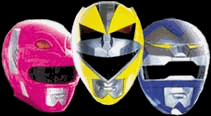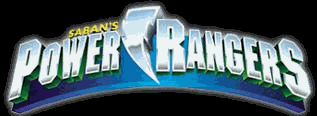|
For over twenty five
years a show called Super Sentai dazzled audiences in Japan. The show
was ( and stil is) a live action show that features five young heroes
with special powers who battle evil monsters. Each one of our heroes
received gigantic robots called mecha. They could be used to fight off
monsters when they grew to gigantic size. The mecha could usually form
together to form one superior gigantic robot. Each year our heroes would
defeat their enemies and our story would be finished. The next year a
new threat and a new set of heroes (with a new back story and brand new
powers) would be introduced and the cycle would repeat itself. The Super
Sentai show was a success in Japan. Although it seemed simplistic by
design Super Sentai shows usually had some story of storyline and even
had some adult situations (Sentai was/is a kids show but in Japan kids
shows have much less content restrictions than in US).
An American television
producer named Haim Saban discovered Super Sentai years before Power
Rangers even aired. He thought of an ingenious business plan that could
make the show a success in the US market. He wanted to buy Super Sentai
footage from Toei ( the company that produced Super Sentai). With the
action footage at his disposal he would hire American actors to shoot
American scenes. The American and Sentai footage would be mixed together
to create a unique kids show.
The only problem was many
Networks did not share Saban's enthusiasm with the idea. Many children's
networks turned his idea down. Saban pitched the idea for years with no
success. Their was a famed un-aired pilot that featured dubbed Bioman
footage ( an early Super Sentai incarnation). Finally Saban was able to
find a Network to air the show. The young Fox Network decided to give
Mighty Morphing Power Rangers ( as the show would come to be called) a
chance.
Young actors were cast to
play the roles of our heroes. Austin St. John was cast to play Jason,
the Red Ranger. Walter Jones was cast to play Zack, the Black Ranger .
Amy Jo Johnson was brought in to play Kimberly, the Pink Ranger. Thuy
Trang was brought in to play Trini,the yellow ranger. To round out the
cast David Yost was cast as Billy, the Blue Ranger. The footage of the
show was taken from the season of the previous years Super Sentai,
which was named Zyuranger. It involved five ancient worriers who were
awakened to use their dinosaur powers to fight an evil witch. Power
Ranger utilized the footage of Zyuranger but had a much different
storyline. MMPR ( as Mighty Morphing Power Rangers is called for short)
was about an evil witch who was freed from her prison on the moon. An
ancient wizard named Zordon recruited our heroes (who were five ordinary
teens) to battle Rita and her evil forces. Rita Repulsa was taken from
the Sentai footage of Zyuranger's main villain, Bandora. Dubbing was
used to give the villian an American sound.

MMPR debuted in the fall
of 1993 on the Saturday morning lineup of Fox Kids ( it should be noted
that an unaired pilot was produced before than that had a different
actor cast as Trini and had some differences than the actual first
episode). Day of the Dumpster was the title of the official first
episode. Power Rangers was aired every weekday morning as well as on
Saturdays. The production values of the show were far from revolutionary
but that was the intent. Power Rangers was this fun campy show with
bright colors. It was supposed to be fun and lacked the complexity or
seriousness of its Sentai counterpart. MMPR was a show kids could watch
without having to think. The Ranger's characters were taken from teenage
stereotypes. The Rangers were excellent role models for kids, as they
seldom did anything wrong. They were perfect characters in the mold of
characters from old classic shows (like Leave it to Beaver or the Brady
Bunch).
Saban was credited as
Executive Producer of the show but he had almost little to do with the
actual production of the show. He fronted the money of course as it was
his company that owned Power Rangers ( Saban Entertainment). Saban's
fellow Executive Producer Shuki Levy, ran the show at this point, along
with a very highly skilled production staff. Producer Jonathon Tzachor
also heavily ran the show. The shows first Supervising Producer (
another name for Story Editor basically) was Tony Oliver. Oliver would
continue on as a Co-Producer after his stint as Supervising Producer
ended. After that he even coming back still for VA roles and to
write/produce specials. Oilver was best known for his role as Rick
Hunter in the Robotech cartoon. He was a key part of PR's early
creation. Around the second or third season a writer on the MMPR writing
staff became the story editor and is credited with some of Power Rangers
greatest episodes from the early seasons. This man is known as Doug
Sloan.
Power Rangers was a huge
success from the get go, vastly becoming the most popular kids show on
television. Toy sales grew out the roof and toy stores were easily sold
out. Kids couldn't get enough of their favorite superhereos. One move
that greatly attributed to Power Ranger's fast growing popularity was
the introduction of a new character. His name was Tommy and he was the
evil Green Ranger sent by Rita to destroy the Rangers ( Saban
Entertainment had earlier requested that Toei create a sixth ranger in
Zyuranger). Tommy was played by Jason David Frank. Soon it was revealed
to the Rangers that Tommy was under an evil spell. After being freed
from the spell he joined the Rangers.
Tommy quickly became the
most popular character on Power Rangers and clearly helped lunch the
franchise. Kids loved Tommy so much that when the writers tried to write
him off ( Tommy was only supposed to be a temporary character) their was
a huge backlash of letters asking that Tommy be kept on. The writers of
MMPR listened to the fans of the show and decided to keep Tommy around
indefinitly (even though his counterpart in Zyuranger was killed off).
MMPR was so popular Saban Entertainment commissioned Toei to create new
Zyuranger footage specifically for Power Rangers. Fox extended Power
Ranger's first season and the new Toei footage was used to produce the
additional episodes required. The extra footage has effectivly been
referred to as Zyu-2 footage.

Power Rangers was easily
renewed for a second season. Seasons two footage was taken from
Zyuranger and the following Super Sentai show ( Dairanger). Our heroes
got new zords and a new villain named Lord Zedd. Lord Zedd was
completely American produced. The show itself took on a more American
feel. Yet the show retained its campy and innocent elements. Tommy was
given completely new powers and became the White Ranger.
Unfortuantely, all was
not happy on the set of Power Rangers at this time. Saban Entertainment
was supposedly underpaying its actors (the actors union was not nearly
as strict on them as they would be later). Actors; Austin St John,
Walter Jones, and Thuy Trang asked for a raise. When it was denied they
refused to continue working. Using stock footage the producers were
luckily able to make it seem like the actors were still there. They
wasted no time to cast replacements for the departed actors. They
quickly wrote the there original characters off by having them sent to
a peace conference. Rocky replaced Jason and was played by Steve
Cardensa. Adam replaced Zack and was played by Johnny Yong Bosch. Aishia
replaced Trini and was played by Karen Ashley . It became a Joke on the
set around that time, that if people weren't good they would be sent to
a peace conference.
MMPR more than survived
the cast change. This was the height of MMPR"s popularity. A movie was
produced featuring the Power Rangers at this time. A take off was
created by Saban Entertainment, called VR Troopers( Jason Frank was
orginally supposed to star in the show,which at the time was called
Cybertron, before fan demand kept him on Power Rangers). The show had
similar theme to Power Rangers and footage was taken from another action
adventure show from Japan. Various PR like series were produced by
revival companies as well. One notable take off was DIC's Super Human
Samuri Cybersquad. It featured four teens who went into a computer to
fight an evil computer program. The show took footage from the Japen
show named Gridman. Their was also the short lived Tattoed Teenagers
From Beverly Hills. Saban would later come out with more take offs of
its own. Mask Rider and Big Bad Beattleborgs were Saban Entertianment's
other PR like projects. Some of these shows had limited success but none
would achieve the level of Power Ranger's own success ( although Big
Badd Bettleborgs always beat PR in the ratings for a short time).
The Power Rangers movie
had mixed succuss. The movie was directed by Bryan Spicer and was
produced by a completely different crew than the show was. The movie was
shot in Sidney, Austrilia. Production values for the movie far exceeded
those of the show. All footage was one hundredd percent original. Paul
Freeman was cast to play the shows villian, Ivan Ozze. Freeman is best
know for his role in "Raiders of the Lost Ark." Interestingly enough,
the movie didn't fit into the shows continunity. This was due to the
fact that 20th Centurty Fox owned the movie and any use of its plot or
props would have forced the show to pay royalities to the movie studio).

MMPR entered its third
season, following the movie ( which had come out in the summer). Season
three utilized footage from the latest Super Sentai series (Kukuranger)
to go with footage from Zyuranger and Dairanger. PR continued as it
always had been. Amy Jo Johnson decided to leave the series and was
replaced by Australian born Actress Catherine Sutherland ( who was cast
to play the character of Katherine Hillard). Originally Sutherland had
been looked at to play a role in the movie ( she auditioned for the
Dulcea role). This helped her get her role in the series.
Unfortunately during the
third season, the popularity of Power Rangers began to wane. As history
shows fads and kids shows don't last long as kids find something else to
flock too. Despite its waning popularity (and end as a fad) PR was still
able to continue on. Toy sales ( although lower) remained high enough to
make the show profitable to all the companies involved. For the shows
fourth season a new fresh direction was planned in hopes of making PR
number 1 again.

|







